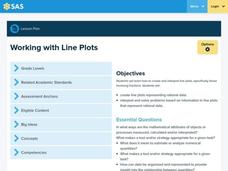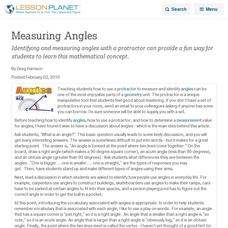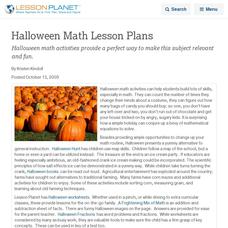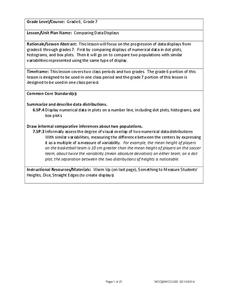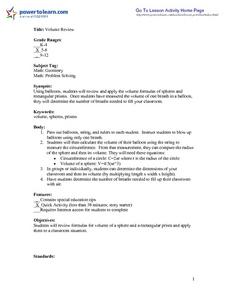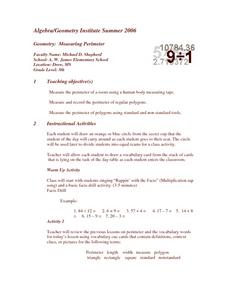Curated OER
Real-life Problems, Money, and Weight
Solve five word problems involving money and weight. After studying the example at the top, which demonstrates how to write out the equation in a word problem, fourth graders work on adding large numbers in money and measurement. Here is...
Buffalo State
A Five Day Approach to Using Technology and Manipulatives to Explore Area and Perimeter
Young mathematicians build an understanding of area and perimeter with their own two hands in a series of interactive geometry lessons. Through the use of different math manipulatives, children investigate the properties of...
Math Worksheets Land
Measure Area by Counting Units - Step-by-Step Lesson
What is the area? Because there is only one problem here with a detailed explanation below, consider projecting this as an all-class warm up. Learners examine a rectangle split into 12 squares. They know that each unit is three...
Curated OER
Measuring Volume/Capacity Using the Metric System
There is more than one way to measure an amount, as learners discover by applying multiple measurement tools in these activities. Centimeter cubes, cylinders, beakers, and measuring cups are used to find the volume of regular and...
Math Worksheets Land
Measure Area by Counting Units - Guided Lesson
Given measurement information on individual squares within a larger shape, scholars determine the total area of that square or rectangle. For one of these three problems they draw the shape knowing its total area and the measurements of...
Curated OER
Applied Science - Science and Math Lab 4B
Learners experiment with the combination of vinegar and baking soda. In this applied science lesson plan, future scientists compare qualitative and quantitative data collected from their exploration. Then they work together to analyze...
Curated OER
Applied Science - Science and Math Lab
Students investigate topology. In this Applied Science lesson students explore higher, more abstract mathematics using tangles. Students make topologically related shapes.
Curated OER
Angles Lesson 15-2
The four major types of angles, right, obtuse, acute, and straight are described in this fine presentation. First, the important vocabulary associated with angles is presented, then the types of angles are described. A protractor is...
Math Worksheets Land
Using Tiling to Find Area - Guided Lesson
By splitting a rectangle into equal parts, scholars can see area as well as calculate it. First, they determine the area of a rectangle given its side lengths. Then, they use the space provided to segment it into four equal parts,...
Curated OER
Length, Perimeter, and Area
Students explore the concepts of length, perimeter, and area. In this math lesson, students use Shape Explorer to practice finding length, perimeter, and area.
Curated OER
Equivalent Measurements of Capacity
Fourth and fifth graders explore equivalent measurements of capacity and learn the size of different units of capacity. In this science lesson plan, pupils identify equivalent measurements of capacity, identify different units of...
Curated OER
Data Analysis, Probability, and Discrete Math
Choose to supplement your probability unit with this resource and you won't be disappointed with the outcome. Teach young mathematicians to organize information using tree diagrams and lists in order to determine the possible outcomes of...
Curated OER
Measuring Angles
Identifying and measuring angles with a protractor can provide a fun way for students to learn this mathematical concept.
Curated OER
Halloween Math Lesson Plans
Halloween math activities provide a perfect way to make this subject relevant and fun.
Curated OER
And You Thought Gasoline Was Expensive!
Students carry out a cost analysis. In this comparative math lesson, students compare the cost of equal measures of gasoline to mouthwash, house paint, fruit juice, white-out, and other liquids.
Berkshire Museum
Adopt a Schoolyard Tree
Help young scientists connect with nature and learn about trees with a fun life science lesson plan. Heading out into the school yard, children choose a tree to adopt, taking measurements, writing descriptions, and drawing sketches of it...
TryEngineering
What is a Nanometer?
Exactly how small is a nanometer? Scholars investigate the scale of a nanometer by measuring classroom objects and converting these measurements to nanometers.
Space Awareness
What is Time?
Does it ever seem like time is slipping through your fingers? Model the passing of time with an hourglass activity in which individuals determine whether hourglasses are the most efficient way to measure time.
Partnership for Educating Colorado Students
Mayan Mathematics and Architecture
Take young scholars on a trip through history with this unit on the mathematics and architecture of the Mayan civilization. Starting with a introduction to their base twenty number system and the symbols they used, this eight-lesson unit...
West Contra Costa Unified School District
Comparing Data Displays
There is so much more to data than just numbers, and this resource has learners use three methods of comparing data in a multi-faceted lesson plan. The 21-page packet includes a warm-up, examples, an activity, and assessment for a...
Curated OER
Volume Review
Pupils investigate the concepts of volume for rectangular prisms and spheres. They measure the volume of one balloon and then consider how many breaths it would take to fill the room with balloons. The rectangular prism being measured is...
Curated OER
Measure Twice, Cut Once
Elementary schoolers learn about metric units and how they are used by engineers. They learn how engineers use the units to measure mass, distance, and volume. Then, they estimate measurements of units, and compare them to actual...
Curated OER
Measuring Perimeter
Have your class practice measuring the perimeter of various objects using this resource. Fifth graders place various-sized polygons in order (from largest to smallest). They use non-standard measuring tools to estimate the distance...
Curated OER
Measure: Perimeter, Area and Volume
Students practice measuring with formulas. In this measurement lesson, students complete an activity that requires them to calculate perimeter, area, and volume.



